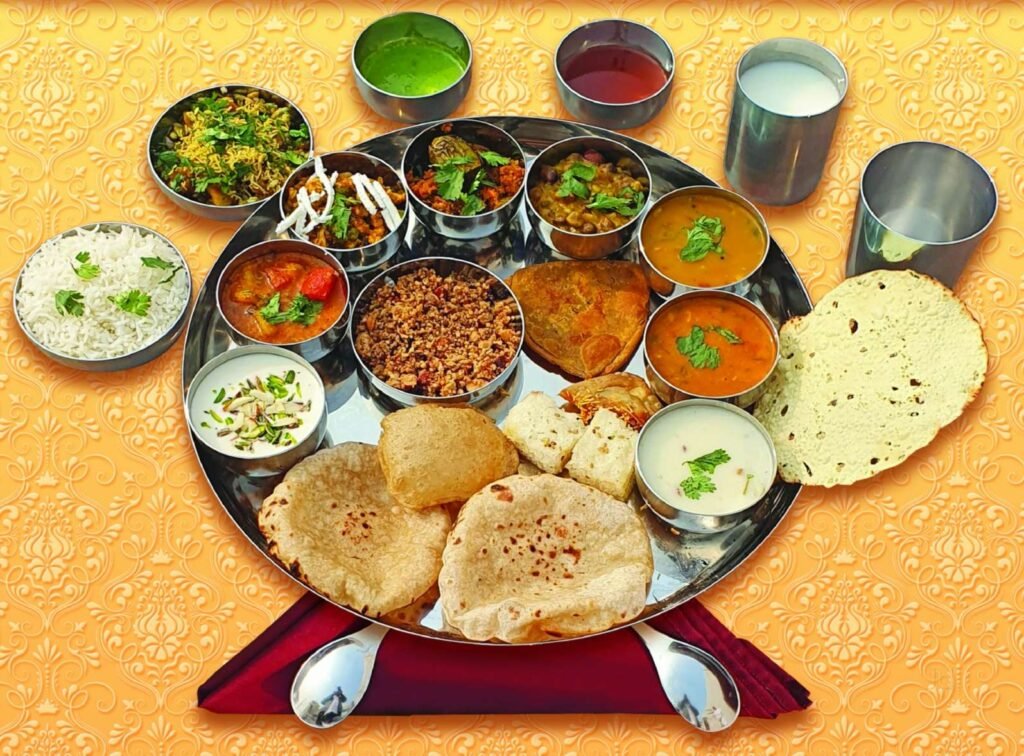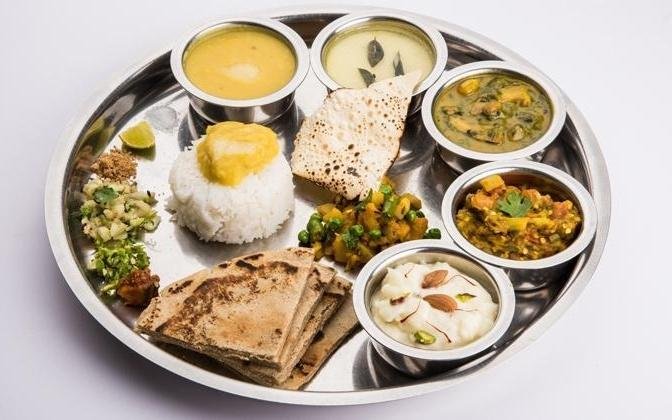A Flavorful Journey: How to Make Authentic Gujarati Full Dish at Home

A Flavorful Journey: How to Make Authentic Gujarati Full Dish at Home
Gujarati cuisine is a tantalizing blend of flavors, spices, and textures that has captivated food enthusiasts worldwide. From its delectable street food to elaborate thali meals, this culinary tradition offers a rich tapestry of tastes and aromas. In this article, we will guide you through the process of preparing a complete Gujarati meal, also known as “Gujarati Full Dish.” Our journey will take you through the essential elements of this delectable cuisine, from curries and dals to dhokla and kadhi. By the end of this culinary adventure, you’ll be able to create an authentic Gujarati feast in the comfort of your own kitchen.
Understanding Gujarati Cuisine:
Before diving into the recipe, let’s familiarize ourselves with the key characteristics of Gujarati cuisine. Known for its predominantly vegetarian nature, Gujarati food is renowned for its subtle yet robust flavors, thanks to the judicious use of spices and the generous inclusion of fresh herbs. Some of the essential features of Gujarati cuisine include:
- Use of Lentils and Legumes: Lentils and legumes such as toor dal (pigeon peas) and mung beans are a staple in Gujarati cooking. These ingredients form the basis of many Gujarati dishes, providing protein and a creamy texture.
- The Sweet and Spicy Balance: Gujarati cuisine strikes a harmonious balance between sweet and spicy flavors. Jaggery, tamarind, and sugar are often used to add sweetness, while spices like mustard seeds, cumin, and green chilies impart heat.
- Inclusion of Yogurt: Yogurt, or dahi, is a common ingredient used in many Gujarati dishes, contributing to their creamy texture and tangy taste.
- Accompaniments and Condiments: A typical Gujarati meal includes an array of condiments and accompaniments like pickles, chutneys, and papads. These add extra dimensions to the dining experience.
Now that you have a basic understanding of Gujarati cuisine, let’s move on to creating a traditional Gujarati Full Dish.
Ingredients for Gujarati Full Dish:
Before you begin, make sure you have the following ingredients at hand:
Note: The quantities mentioned here are approximate and can be adjusted according to your taste preferences.
- For Dhokla:
- 1 cup gram flour (besan)
- 1/2 cup yogurt (dahi)
- 1/2 teaspoon turmeric powder (haldi)
- 1 teaspoon ginger-green chili paste
- Salt, to taste
- 1 teaspoon Eno fruit salt
- 2 tablespoons oil
- 1 teaspoon mustard seeds (rai)
- A few curry leaves
- For Kadhi:
- 1 cup yogurt (dahi)
- 2 tablespoons gram flour (besan)
- 1/2 teaspoon turmeric powder (haldi)
- 1/2 teaspoon fenugreek seeds (methi)
- 1/2 teaspoon mustard seeds (rai)
- 2-3 green chilies, slit
- A pinch of asafoetida (hing)
- 2 cups water
- Salt, to taste
- For Aloo Sabzi:
- 2 large potatoes, peeled and cubed
- 2 tablespoons oil
- 1 teaspoon mustard seeds (rai)
- 1/2 teaspoon cumin seeds (jeera)
- 1/2 teaspoon turmeric powder (haldi)
- 1/2 teaspoon red chili powder
- 1 teaspoon coriander-cumin powder (dhania-jeera powder)
- Salt, to taste
- For Gujarati Dal:
- 1/2 cup toor dal (split pigeon peas)
- 1/2 teaspoon turmeric powder (haldi)
- 1/2 teaspoon red chili powder
- 1 teaspoon jaggery
- 2 tablespoons tamarind pulp
- 1 tablespoon ghee (clarified butter)
- 1/2 teaspoon mustard seeds (rai)
- A pinch of asafoetida (hing)
- A few curry leaves
- For Accompaniments and Condiments:
- Pickles, chutneys, and papads (store-bought or homemade)
- Chopped fresh coriander leaves for garnish
Instructions:
Now that you have gathered all the necessary ingredients, let’s start preparing the Gujarati Full Dish.
1. Dhokla:
a. In a mixing bowl, combine the gram flour, yogurt, turmeric powder, ginger-green chili paste, and salt. Add enough water to form a smooth, thick batter.
b. Grease a steamer plate or a thali and pour the batter into it.
c. Steam the batter for about 15-20 minutes or until a toothpick inserted comes out clean.
d. Once steamed, let the dhokla cool for a few minutes and then cut it into diamond or square-shaped pieces.
e. In a small pan, heat oil, add mustard seeds, and curry leaves. When the seeds splutter, pour this tempering over the dhokla pieces.
2. Kadhi:
a. In a mixing bowl, whisk the yogurt, gram flour, turmeric powder, and salt with 2 cups of water until well combined.
b. In a deep pan, heat 1 tablespoon of oil. Add fenugreek seeds, mustard seeds, green chilies, and asafoetida.
c. Pour the yogurt mixture into the pan and let it simmer on low heat until it thickens. Stir continuously to avoid lumps.
3. Aloo Sabzi:
a. Heat oil in a pan, add mustard seeds and cumin seeds. When they splutter, add turmeric powder, red chili powder, and coriander-cumin powder.
b. Add the cubed potatoes and salt. Cook until the potatoes are tender and have a golden crust.
4. Gujarati Dal:
a. Wash and pressure-cook the toor dal with turmeric powder, red chili powder, and salt until it’s soft and well-cooked.
b. In a separate pan, heat ghee, add mustard seeds, asafoetida, and curry leaves. Pour this tempering over the cooked dal.
c. Add jaggery and tamarind pulp to the dal. Simmer for a few more minutes, adjusting the consistency with water if needed.
5. Assembling the Full Dish:
a. Arrange a portion of dhokla, aloo sabzi, kadhi, and Gujarati dal on a plate.
b. Serve with pickles, chutneys, and papads.
c. Garnish with fresh coriander leaves.
Congratulations! You’ve now prepared a complete Gujarati Full Dish, complete with dhokla, kadhi, aloo sabzi, Gujarati dal, and a variety of accompaniments.
Enjoy your homemade Gujarati feast, bursting with the flavors
and aromas that make this cuisine so special. Gujarati food is all about balance and harmony, and this dish exemplifies the delightful interplay of sweet, spicy, and tangy elements. So, gather your ingredients and give it a try, and you’ll experience the true essence of Gujarat’s culinary traditions right in your own kitchen. Happy cooking!
6. Accompaniments and Condiments:
One of the remarkable features of Gujarati cuisine is the variety of accompaniments and condiments that accompany the main dishes. These flavorful additions play a crucial role in elevating the meal. Here are some common accompaniments and condiments to consider:
a. Pickles: Gujarati pickles come in various flavors, ranging from spicy and tangy to sweet and sour. Mango pickle (aam ka achar) and lemon pickle (nimbu ka achar) are popular choices. They add a burst of flavor to the meal and provide a contrast to the mildness of some dishes.
b. Chutneys: Fresh and tangy chutneys are an integral part of Gujarati cuisine. Some favorites include coriander chutney (dhania chutney) and tamarind chutney (imli chutney). These chutneys complement the main dishes and are often served with snacks like dhokla and thepla.
c. Papads: Papads, or papadums, are thin, crispy discs made from lentil or rice flour. They add a delightful crunch to the meal and can be roasted or fried. Some popular papad varieties include urad dal papad and moong dal papad.
7. The Art of Plating:
Gujarati cuisine takes great pride in its visually appealing presentation. When assembling your Gujarati Full Dish, pay attention to how you arrange the components on the plate. Here are some tips for artful plating:
a. Balance of Colors: Use colorful ingredients to create a visually appealing plate. The bright yellow dhokla, the creamy white kadhi, the vibrant red aloo sabzi, and the earthy hues of Gujarati dal all come together to form a beautiful plate.
b. Garnish: Garnish with freshly chopped coriander leaves, as it not only adds a burst of green but also a fresh, herbal aroma to the dish.
c. Use of Accessories: Consider using traditional Gujarati accessories such as stainless steel or copper thalis (plates) for a more authentic feel.
8. Serving Traditions:
Gujarati meals often follow specific serving traditions. Here are a few customs to consider:
a. Thali Service: Gujarati meals are traditionally served in a thali, a round platter with compartments for each dish. This enhances the dining experience and allows you to savor a variety of flavors in one meal.
b. Served Warm: Gujarati food is best enjoyed when served warm. Keep your dishes hot and fresh for the best taste and texture.
c. Share and Bond: Gujarati culture values community and togetherness. Meals are often a time for family and friends to come together, share stories, and enjoy each other’s company. So, consider serving your Gujarati Full Dish in a communal style, encouraging everyone to take from the thali and pass it around.
9. Dietary Considerations:
While Gujarati cuisine is predominantly vegetarian, it also offers a wide array of options for those with specific dietary preferences or restrictions. If you’re looking to make this meal vegan or gluten-free, there are easy substitutions and modifications available. For instance, you can use plant-based yogurt in the kadhi, and there are gluten-free variations of dhokla available as well.
10. Explore Regional Variations:
Gujarati cuisine is incredibly diverse and is not limited to the recipe mentioned in this article. Different regions of Gujarat have their own unique specialties and variations. For example, the Surti Undhiyu, a winter specialty from Surat, or the Kathiawadi cuisine from the Saurashtra region, offer distinctive flavors and ingredients. Exploring regional variations can open up a whole new world of Gujarati food.
In conclusion, the Gujarati Full Dish is a culinary journey that combines sweet, spicy, and tangy flavors into a harmonious and satisfying meal. Whether you’re an experienced cook or a novice, this recipe is accessible and adaptable to your taste preferences. So, gather your ingredients, follow the steps outlined in this article, and embark on a delightful journey into the world of Gujarati cuisine. You’ll not only satisfy your taste buds but also gain a deeper appreciation for the rich culinary heritage of Gujarat. Happy cooking, and enjoy your homemade Gujarati feast!
